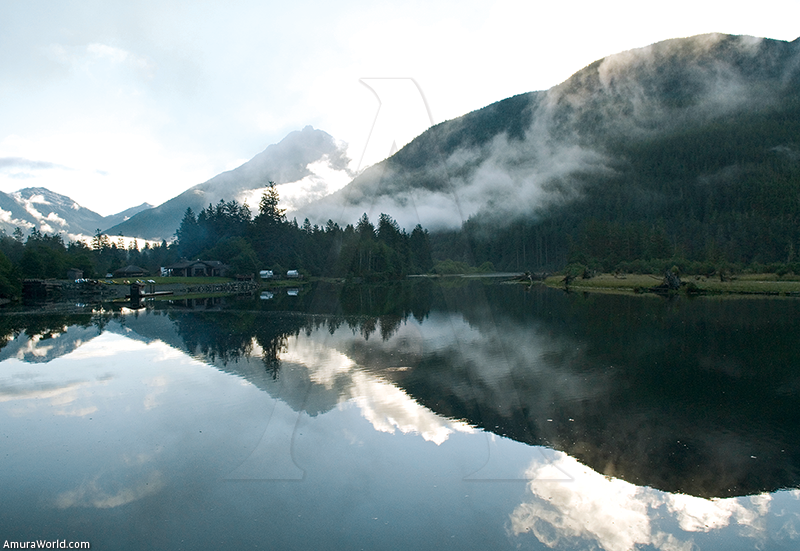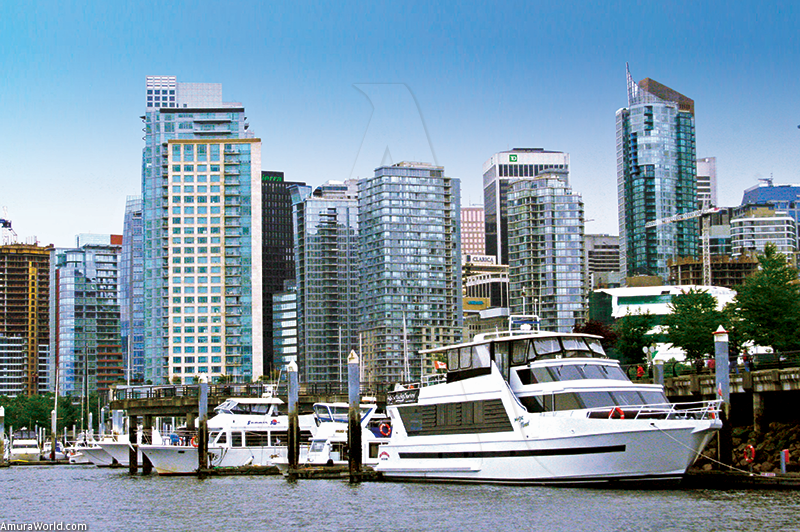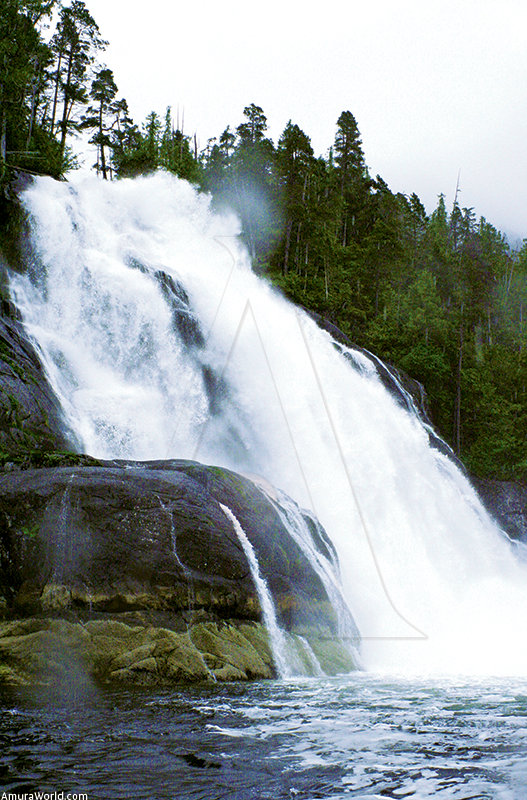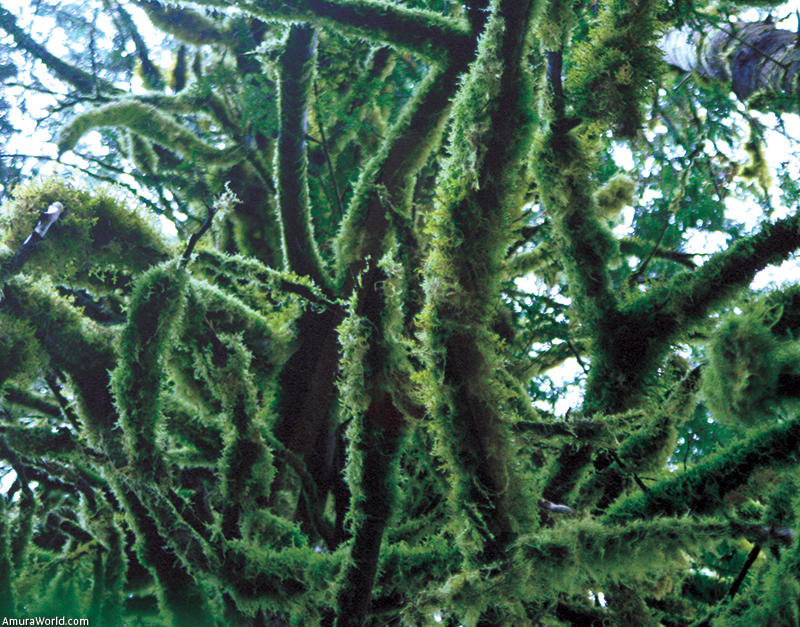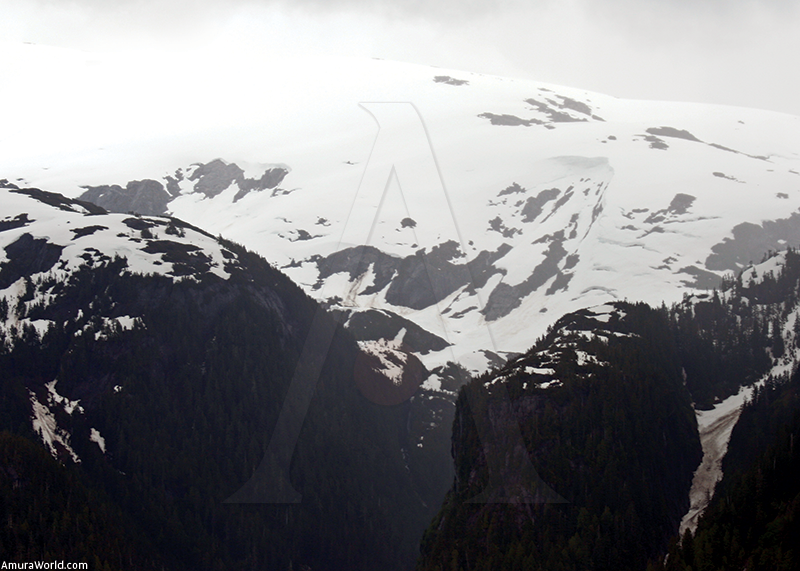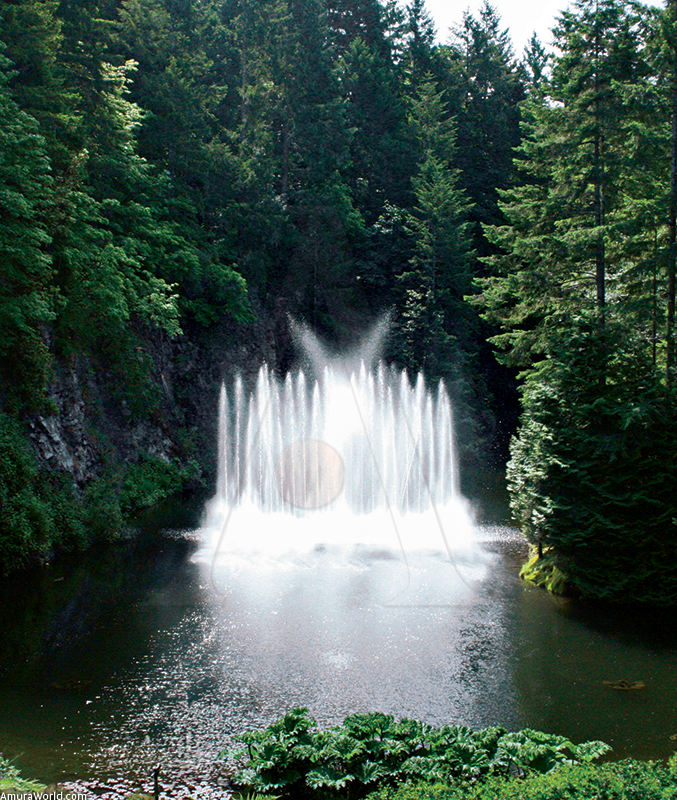From Bella-Bella to Prince Ruppert
Like from a storybook, one of the most beautiful regions in the world lay hidden in the northwest part of Canada: mountains that outline majestic fjords, islands in all their splendor and in plain view of glacier summits. At Whistler, there is skiing all year round, while in Vancouver, one can sail; in Victoria, the sun shines upon flowers; and in the north, bears are owners of extraordinary scenery. British Columbia is a region of great natural beauty, a spectacular place to sail.
Vancouver
The city is surrounded by sea and lies at the foot of the mountains, at the mouth of the Fraser River. Vancouver is a city of dreams in which tall buildings line streets with an atmosphere of a big little town.
Stores and restaurants are surprisingly diverse. Through its bustling commerce, Chinatown invites passersby to assimilate an authentic Asian atmosphere, while Yaletown is renowned as the best area for both stores and restaurants. And of course, fantastic walks along the beach to enjoy a mild and humid climate.
Gastown is a Vancouver neighborhood famous for its historical and architectural charms, featuring cob- blestone alleys, a famous gas clock and streets lined with small bars and taverns. Visits can be made either on foot or bicycle, enabling one to enjoy Stanley Park, a big rainforest park at the north end of town, as well as the site of an extraordinary aquarium. Discover Granville Island with its small neighborhood atmosphere and bustling streets; Point Grey with its pictur- esque public spaces and big mansions; the campus of the University of British Columbia, where you can visit an impressive Archeological Museum with a lovely collection of totem poles; and of course the Botanical Garden.
Thanks to its mild climate, Vancouver offers visitors a variety of gardens, including the notable Dr. Sun Yat Sen Classical Chinese Garden and VanDusen Botanical Garden. Also worth noting are the beautiful walks along Grouse Mountain via the cable car and the hanging bridge across the Capilano River, not to men- tion the option of mounting a sea raft or kayak. The Vancouver Lookout tower is an exceptional vantage point to admire the big city with a heart, where the white peaks of the Canada Place exhibition center compete in beauty with great cruise ships; a place where sail boats dot the bay and culture is racially diverse; an immersion in a harmonious world. Vancouver Art Gallery exhibits art in the center of a city with neigh- borhoods that vibrate at all hours of the day (Yaletown) and places with enchanted atmosphere (Davie Village).
Leaving the marina, at the foot of the Devonian Harbor Park, we sail in Coal Harbor to admire the sump- tuous Waterfront with its elegant buildings and famous Lions' Gate Bridge that unites Vancouver with the northern coast, located at the foot of snow covered mountains. Surrounding Stanley Park the view is beautiful, with crowded, lovely beaches during the summer months in plain view of the spectacular Vancouver skyline.
From Bella-Bella to Rescue Cove
After flying over Vancouver Island and the north coast during more than two hours, we arrive at Bella Bella, a small village where the sailboat Island.
Our trip begins by veering north toward an area full of islands; channels and fjords nestled between snow- peaked mountains, lush forests and spectacular water- falls. Thanks to this intricate setting, the trip takes place in sheltered and calm waters, even though on the few occasions we were exposed to open sea the waves picked up considerably.
On the first day of the trip, after facing waves near Faro Ivory, we headed to Mathieson Channel to observe strange cave paintings at the entrance to Oscar Pass, composed over a steep rock by indigenous peoples, now called “First Nation People”. These people came from Asia and were the last to arrive and settle down in this cold, inhospitable area, living in small dwellings and dedicated to both hunting and fishing. We anchor in Rescue Cove, an excellent bay protected by the high mountains and caressed by fog.
From Rescue Cove to Windy Pass
After sailing in kayak, we lift anchor beneath a dark sky to head toward Finlayson Channel, a long, well protected natural channel where we discover eight killer whales (Orcas) that we follow a while to observe. This was a marvelous experience; the whales surfaced to breathe, showing off their black and white bodies and tails. At times, they were so close we could hear the sounds they make when they expel air, as well as see their eyes. A humpback whale got close to the Island Odyssey while we followed the killer whales to Oscar Pass.
We headed north, aided by moderate wind, and final- ly arrived at the small town of Klemtu. a village protected within the Finlayson Channel. A short walk allowed us to observe the simple life of its inhabitants, people with Eskimo features, as well as visit the Big House where Francis talked about village life and the possibili- ty of catching a glimpse of the white spirit, big black bears that, as a result of genetic deformation, grow white hair. This is the only region where these strange animals can be observed, although they are difficult to find.
Big House was finished in 2002 and has magnifi- cently sculpted and painted totem poles that represent the coat of arms of the Kitasoo and Xaixais, local Indian tribes. Grizzly bear, black bear, killer whales, eagles and frogs are represented on these poles in a stylish and elegant manner. Bald eagles watched us during our visit to the village, hovering at the foot of mountains covered with wet forests, where the ocean becomes dizzy and looks like a lake.
Along our route we observed sea lions before finally heading into Sheep Passage, where a beautiful waterfall greeted us before we ended our day by anchoring in Windy Pass, a tranquil refuge at the foot of steep glaciers.
From Windy Pass to Kynoch inlet
A morning walk in the forest helped get us acquainted with the likens, mushrooms, moss and flowers that all grow in this forest, where snow falls abundantly in the highlands all year round but rarely touches the ground at sea level, which gets mostly rain. We sail along Sheep Passage to observe beautiful cascades that fall from the heights of giant coastal mountains, until arriving at Mussel Inlet, where we anchor to walk along the estuary in which surging rivers fall violently from glaciers. We observe four grizzly bears eating in the estuary, all fully aware of our movements, while other two animals walked over an ice patch. They are impressive beasts; in fact, we were lucky to be able to walk near them; we got so close that only a river separated us.
Passing Heikish Narrows, a tight passage where we observe a sea lion perched on a rock, we enter Kynoch Inlet, a long, narrow fjord where we encounter a waterfall worthy of legend, a cascade plunging abruptly into the sea. The sailboat got close enough to stick the bow into the waterfall, causing strong emotions typical of the most exot- ic adventures. We anchored at the end of Kynoch Inlet, sailed in zodiak across Culpepper Lagoon, where many geese had chosen to reside.
From Kynoch inlet to Khutze inlet
Returning along Sheep Channel, we came across six porpoises that accompanied us for a time, play- ing with the bow of the sailboat. We entered Carter Bay. where the surface of the S.S. Ohio’s bow can be seen, a ship that sunk here more than 100 years ago. We walked along the river in the storybook rainforest before beginning a tour of Princess Royal Channel and then entering Khutze Inlet, where we anchored in front of a beautiful waterfall and spent the night in the lovely bay surrounded by white-capped mountains.
We searched the estuary in kayak, entering in an offshoot of the river when we suddenly discov- ered two young grizzly bears playing and eating grass. We observed them at close distance until one got up and approached the river to drink water. We were closer than 50 meters from him. admiring his impressive claws and hulking body. It was one of the most exciting moments of the trip, being able to observe these animals until finally deciding to disappear in the forest. Seals, harlequin ducks, trumpet swans, crabs and birds enlivened the wonderful scenery.
From Khutze Inlet to Bishop Bay
After exploring Aaltanhash Inlet and walking in the forest along the riverbank. we continued our tranquil voyage to Butedale. an old salmon-can- ning town. After housing a population of nearly 2,500 inhabitants, the town closed down in 1966. It now seems like a ghost town, with crumbling buildings that fall into the sea. Only one resident remains. Lou. who tries to maintain a semblance of order, accompanied by his dog Bert and a few cats; living in effect in the middle of a forest next to a cascade that plunges into an incredible lake.
That day Lou had a guest, a young man who came to visit in kayak from Seattle, camping along the shore where bears are always a threat. At night, we anchored in Bishop Bay. where we paddled around in hot water from a spring in the middle of the forest. A few plunged into the icy sea. The for- est resounded with our laughter and voices, while the mountains trembled.
From Bishop Bay to Hartley Bay
We had a truly scientific expedition in Monkey Beach; taking advantage of the low tide, we studied the great variety of starfish, crabs, shells and anemones. We also visited the remains of an old indigenous campground on a white beach full of broken shells. Following the channel, we reached the southern part of the island Gribbell, famous for its white spirit which, unfortu- nately. we did not find.
Hartley Bay is a small town with a floating dock that received our sailboat and followed the tide and streets that seemed like perfectly set tables. We visited the church, the Big House with its carved and painted columns and totem poles, the ice cream vendor and the beautiful lake behind the town. We anchored in Coghlan Bay. observing the considerable difference between high and low tide.
From Hartley Bay to Baker Inlet
Marvin, a resident of the town, took us in his aluminum boat along Douglas Channel to see the fabu- lous Kishkosh Inlet, a fjord that ends in an impressive arrangement of glacier-crowned moun- tains animated by waterfalls. We saw a deer swam across the fjord, a black bear with two cubs and a wolf that observed us from a distance, forcing his family to hide in the forest. We also encountered a bison that tiptoed along the edge of the shore, as well as bald eagles that flew from pine to pine. We visited Kitkata Inlet, where we saw the site of the old town at the mouth of the River Quaal. with its intriguing carved stones with faces, birds and geometric motifs. Marvin told us about the life of his ancestors, how they hunted and fished. A solitary black bear observed us from afar and, during the trip, we admired at close range a bear on a small beach.
On board the Island Odissey again, we headed north along Grenville Channel accompanied by killer whales, observing how the north and south currents united in this long natural channel. Finally, we entered in a narrow channel. Watt Narrows, until anchoring in the calm Baker Inlet to spend the night.
From Baker inlet to Prince Ruppert
It was an exciting experience to travel along Watt Narrows at daybreak, observing the strong current caused by the dropping tide. In Grenville Channel, a few killer whales followed us. Once past Lewis Point, however, we found ourselves without protection; the ocean turned restless and we were assaulted by rain and wind that lasted until we arrived at Prince Ruppert. an important port and decent sized city. Once there, we visited an interesting museum called First Nation People, with its fabulous collec- tion of totem poles and craft objects.
From the seaport to the airport and from Prince Ruppert to Vancouver, the adventure had ended.
We had finally left the majestic fjords, the natural beauty of rainforests, the greatness of mountains covered with snow even when June beckoned in summer, and the excitement of seeing bears, whales and eagles.
Whistler
We reached Whistler along the highway that fol- lows Horseshoe Bay. arriving at the seductive ski resort lined with exquisite restaurants and luxury hotels. At the end of spring, the trees sparkled and snow covered the rocky heights.
We played golf in magnificent fields, skied in the wonderful trails of Blackcomb Mountain, and left in a cabin suspended by cables on top of a tor- rent in a gully. It was a great adventure to travel makeshift trails on mountain bikes and stumble onto bears.
Whistler, nestled in magnificent scenery of forest-covered mountains, is a fantastic place to discover nature at any time of year and have an incredible time.
victoria
We reached the southern part of Vancouver Island in hydroplane, which took us to the beautiful port nestled at the bottom of an inlet. The hotel Empress Fairmont dominates this port and the city where the splendid energy of the western Canadian coast harmonizes with English customs.
Old buildings line streets in which people walk or sit on terraces. The Victorian government building sits imposingly near the dock, where a few boats beckon passersby into walking or visiting Fisherman’s Wharf, an area featuring houses built on water, active hungry seals, museums full of totem pole art and. of course, excellent dining at restaurants such as L’Ecole. The parks are true jewels. the star being Butchart Garden, where rhododendrons compete in beauty with every type of iris, daisy and rose. Also located in the area are Abkhazi Garden. Glendale Gardens and Woodlands.
New Marine Center at Sydney, etc. Victoria and the surrounding area present an extraordinary panorama of culture and nature.
British Columbia is unique part of the world that allows us to glimpse the possibility of harmony between human beings, nature and wonderful scenery. One of the most beautiful and harmonious places in North America, it features fjords that dot an enigmatic and splendid coast, and people who are truly in touch with their sur- roundings. British Columbia is an authentic treasure.
A Great Ecological Adventure
The province of British Columbia is one of the best places in the world to observe the fauna in its own habitat.
In Whistler, next to the village, the black bears are easily noticeable, they coexist with the people, but. of course, you must have some respect, they are beautiful but they do not stop being danger- ous. It is also very feasible to find a grizzly bear, the biggest, and impressive for its claws and its height. In the Woods there are deers, moose, and lambs of great antlers, mountain goats and wolves. The mountains and the less populated fiords of the north are the best places to watch them, and maybe discover the white spirit, black bear of white color due to a genetic deformation.
In the sky is easy to admire the bald eagle, sumptuous animal, magnificent in its flight or in top of the pines. You can enjoy bird watching, such as the Canadian magpie, geese, ducks, loons, snow owls, woodpeckers, hummingbirds, swans, and etcetera.
In the sea is possible the encounter with orcas. as well as the whale watching, sea otters, seals, dolphins, harbor porpoises or sea lions. In the beaches, when the tide lowers, the sea stars com- pete in beauty, and a great variety of shells, crabs and seaweeds are part of a striking world.
For the fishing lovers, the sea and the rivers are a marvelous adventure with salmons, trout, groupers and sea bass, among others.
The world of trees, flowers, lichens, mushrooms and plants is almost an endless pleasure in the obser- vation of this nature that vibrates, throbs, in a region that fascinates for its beauty.Text: Patrick Monney ± Photo: Patrick Monney

